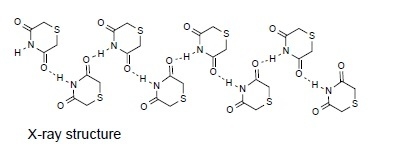Tetrahydro-1,4-thiazine-3,5-dione
Abstract
:1. Introduction
2. Results
3. Experimental
Tetrahydro-1,4-thiazine-3,5-dione (1)
Supplementary Materials
Author Contributions
Conflicts of Interest
References
- Barkenbus, C.; Landis, P.S. The Preparation of 1,4-Thiazine. J. Am. Chem. Soc. 1948, 70, 684–685. [Google Scholar] [CrossRef]
- Aitken, R.A.; Farrell, D.M.M.; Kirton, E.H.M. Synthesis and Pyrolysis of Tetrahydro-1,4-oxazine-3,5-diones and Tetrahydro-1,4-thiazine-3,5-diones. Chem. Heterocycl. Compd. 2001, 37, 1526–1531. [Google Scholar] [CrossRef]
- Aitken, R.A.; Aitken, K.M.; Carruthers, P.G.; Jean, M.A.; Slawin, A.M.Z. 1,4-Oxazine. Chem. Commun. 2013, 49, 11367–11369. [Google Scholar] [CrossRef] [PubMed] [Green Version]
- Szawkalo, J.; Maurin, J.K.; Plucinski, F.; Czarnocki, Z. Synthesis and dynamic stereochemistry of 4-aryl-thiomorpholine-3,5-dione derivatives. J. Mol. Struct. 2015, 1079, 383–390. [Google Scholar] [CrossRef]
- Ramasubbu, N.; Parthasarathy, R.; Tsoucaris, G. Structure of thiomorpholine-3-one: Comments on the geometry of monocoordinated metal complexes. Acta Crystallogr. Sect. C 1988, 44, 2016–2018. [Google Scholar] [CrossRef]
- Bhuiyan, M.D.H.; Jensen, P.; Turner, P.; Try, A.C. 4-(2-Methoxy-4-nitrophenyl)morpholine-3,5-dione. Acta Crystallogr. Sect. E 2007, 63, o1115–o1116. [Google Scholar] [CrossRef]
- Martínez-Palau, M.; Urpí, L.; Solans, X.; Puiggalí, J. Morpholine-2,5-dione. Acta Crystallogr. Sect. C 2006, 62, o262–o264. [Google Scholar] [CrossRef] [PubMed]
- Sheldrick, G.M. A short history of SHELXL. Acta Crystallogr. Sect. A 2008, 64, 112–122. [Google Scholar] [CrossRef] [PubMed]





| Bond | Length/Å | Bond | Length/Å |
|---|---|---|---|
| S(1)–C(2) | 1.804(2) | S(11)–C(12) | 1.799(2) |
| S(1)–C(6) | 1.807(3) | S(11)–C(16) | 1.797(3) |
| O(3)–C(3) | 1.230(3) | O(13)–C(13) | 1.231(3) |
| O(5)–C(5) | 1.227(3) | O(15–C(15) | 1.223(3) |
| N(4)–C(3) | 1.375(3) | N(14)–C(13) | 1.370(3) |
| N(4)–C(5) | 1.400(3) | N(14)–C(15) | 1.396(3) |
| N(4)–H(4N) | 0.975(5) | N(14)–H(14N) | 0.976(5) |
| C(2)–C(3) | 1.500(3) | C(12)–C(13) | 1.503(3) |
| C(5)–C(6) | 1.496(3) | C(15)–C(16) | 1.503(3) |
| Angle | Value/° | Angle | Value/° |
|---|---|---|---|
| C(2)–S(1)–C(6) | 97.48(11) | C(12)–S(11)–C(16) | 96.37(11) |
| C(3)–N(4)–C(5) | 129.08(19) | C(13)–N(14)–C(15) | 128.60(19) |
| C(3)–N(4)–H(4N) | 113.0(13) | C(13)–N(14)–H(14N) | 114.6(15) |
| C(5)–N(4)–H(4N) | 117.4(13) | C(15)–N(14)–H(14N) | 116.6(15) |
| C(3)–C(2)–S(1) | 112.69(16) | C(13)–C(12)–S(11) | 113.30(16) |
| O(3)–C(3)–N(4) | 118.8(2) | O(13)–C(13)–N(14) | 119.0(2) |
| O(3)–C(3)–C(2) | 122.1(2) | O(13)–C(13)–C(12) | 122.1(2) |
| N(4)–C(3)–C(2) | 119.03(19) | N(14)–C(13)–C(12) | 118.85(19) |
| O(5)–C(5)–N(4) | 119.2(2) | O(15)–C(15)–N(14) | 118.6(2) |
| O(5)–C(5)–C(6) | 121.6(2) | O(15)–C(15)–C(16) | 121.8(2) |
| N(4)–C(5)–C(6) | 119.2(2) | N(14)–C(15)–C(16) | 119.5(2) |
| C(5)–C(6)–S(1) | 115.51(16) | C(15)–C(16)–S(11) | 114.20(17) |
| D—H⋯A | D—H | H⋯A | D⋯A | D—H⋯A |
|---|---|---|---|---|
| N(4)–H(4N)⋯O(13) | 0.975(16) | 1.938(16) | 2.894(3) | 166.1(15) |
| N(14)–H(14N)⋯O(3) | 0.98(2) | 1.96(2) | 2.917(3) | 167.3(18) |
© 2018 by the authors. Licensee MDPI, Basel, Switzerland. This article is an open access article distributed under the terms and conditions of the Creative Commons Attribution (CC BY) license (http://creativecommons.org/licenses/by/4.0/).
Share and Cite
Aitken, R.A.; Slawin, A.M.Z.; Yeh, P.-p. Tetrahydro-1,4-thiazine-3,5-dione. Molbank 2018, 2018, M1036. https://doi.org/10.3390/M1036
Aitken RA, Slawin AMZ, Yeh P-p. Tetrahydro-1,4-thiazine-3,5-dione. Molbank. 2018; 2018(4):M1036. https://doi.org/10.3390/M1036
Chicago/Turabian StyleAitken, R. Alan, Alexandra M. Z. Slawin, and Pei-pei Yeh. 2018. "Tetrahydro-1,4-thiazine-3,5-dione" Molbank 2018, no. 4: M1036. https://doi.org/10.3390/M1036






